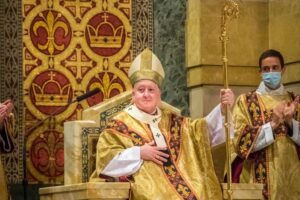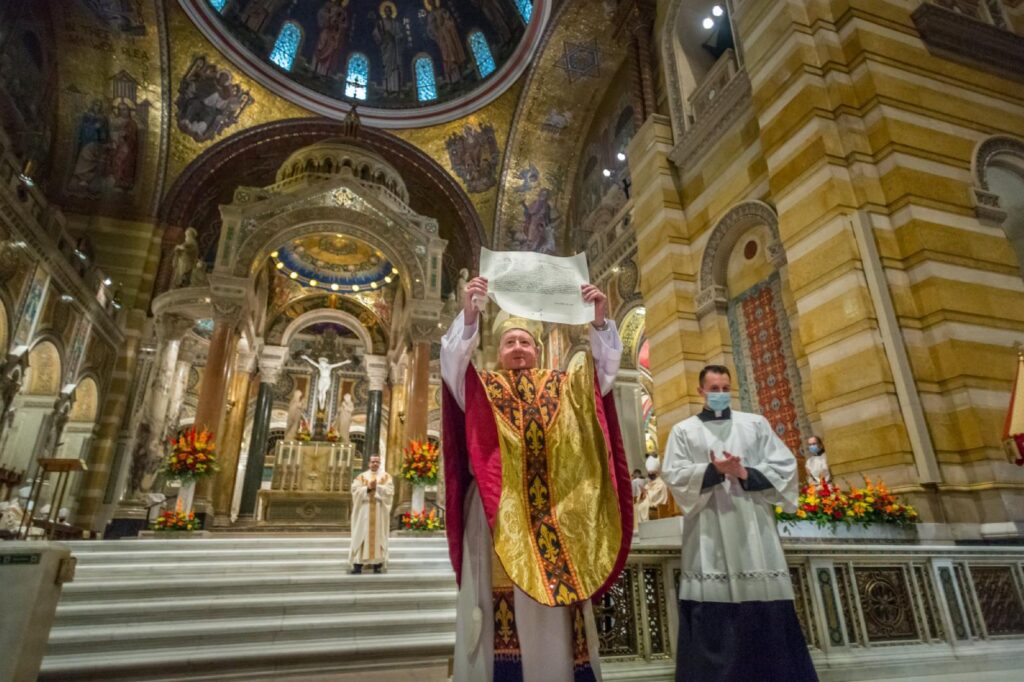
Sitting on a couch in the small TV room of her Dundalk rowhouse, Jean Rozanski watched in awe as images of her son flashed on her screen from more than 820 miles away.
The livestreamed video on a Catholic television network showed what the 84-year-old mother of three still can’t quite fathom: Mitchell T. Rozanski, her eldest son and a product of working-class East Baltimore, was being installed as the 10th archbishop of St. Louis, one of the most prominent American dioceses.
The Aug. 25 liturgy was attended by approximately 500 people at the Cathedral Basilica of St. Louis, a number limited by the coronavirus pandemic to only a fraction of what the grand cathedral can hold. Thousands more, including many in Baltimore, were watching remotely via livestream.
“It was so unbelievable,” marveled Jean Rozanski, who watched the liturgy with her 86-year-old husband, Alfred, and a family friend. “I’m just so very proud of him. There were moments when I was emotional.”
Archbishop Rozanski’s Baltimore roots run deep, and they have grounded his ministry with a distinctive focus on pastoral outreach, dialogue, charity and openness.
‘Down-to-earth’
Archbishop Rozanski, 62, grew up in Holy Rosary Parish in Fells Point before his family moved to Dundalk and attended Sacred Heart of Mary in Graceland Park. The son of a Bethlehem Steel police officer who also worked as a security guard at Allied Signal, the future bishop was educated by the Felician Sisters at Holy Rosary School and the Sisters of the Holy Family of Nazareth at Sacred Heart of Mary School.

Archbishop Rozanski graduated from Our Lady of Mount Carmel High School in Essex in 1976, where he had been president of the student government and was influenced by the Franciscan Sisters of Philadelphia who staffed the school.
Jean Rozanski said her son first expressed an interest in the priesthood around age 15. He had the full support of his parents, with her husband telling the future bishop that if he ever decided the seminary was not for him, he could come home any time.
After his priestly ordination in 1984 by Archbishop William D. Borders, Archbishop Rozanski served as a parish priest before being named an auxiliary bishop of Baltimore in 2004 – the youngest American bishop of that time – and then bishop of the Diocese of Springfield, Mass., in 2014.
“I think he touches many people’s lives,” said Jean Rozanski, noting that because her husband had a stroke, they could not be with their son in person for his installation. Archbishop Rozanski’s younger brothers, Kenneth and Albert, and two of his nephews, Kyle, 21, and Dalton, 15, represented the family at the installation, she said.
“He’s very down-to-earth,” she said. “He’s a good listener and he really tries to help everyone.”
Baltimore influence
A day after his ordination, Archbishop Rozanski credited his experiences in the Archdiocese of Baltimore with shaping his approach to ministry and leadership.
The priests of the Archdiocese of Baltimore have been heavily influenced by Cardinal Lawrence Shehan right up to the present day, Archbishop Rozanski said.
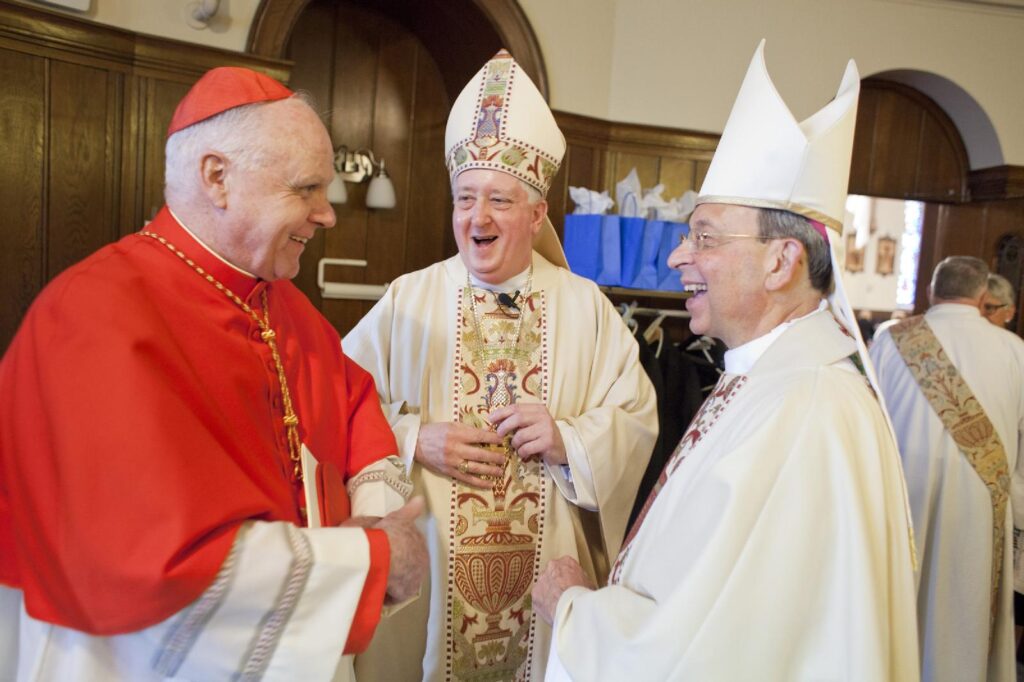
“Cardinal Shehan was prophetic in the ways that he implemented Vatican II, in how he fought for racial justice, in the ways that he was very clear in the teachings of the church and also the way that he implemented the social teachings of the church,” Archbishop Rozanski said. “That’s what really helped shape the spirit of the Archdiocese of Baltimore.”
Archbishop Rozanski noted that as an auxiliary bishop in Baltimore for a decade, he saw the leadership style of three archbishops: Cardinal William H. Keeler, Cardinal Edwin F. O’Brien and Archbishop William E. Lori.
He described Cardinal Keeler as a man who brought an ever-present sense of the universality of the Catholic Church to Baltimore. Cardinal O’Brien was a decisive leader who assessed situations thoroughly and then implemented decisions, Archbishop Rozanski said, and Archbishop Lori has shown the importance of bringing people together in consensus.
“From each of them, I learned what it means to be a bishop,” Archbishop Rozanski said, adding that each of the archbishops he served provided “wonderful outreach” to their people and were “very solicitous” of the priests of the archdiocese – traits he has tried to emulate as a spiritual shepherd himself.
Modeling a French saint
Archbishop Rozanski told the Catholic Review he intentionally selected the Feast of St. Louis as his installation date because the medieval French king for which his new city is named had a “great sense in his heart that he was subject to a higher power: God and the heavenly realm.”
The only king of France who is a canonized saint, St. Louis IX was known for his love of the poor and for his diplomatic skills.
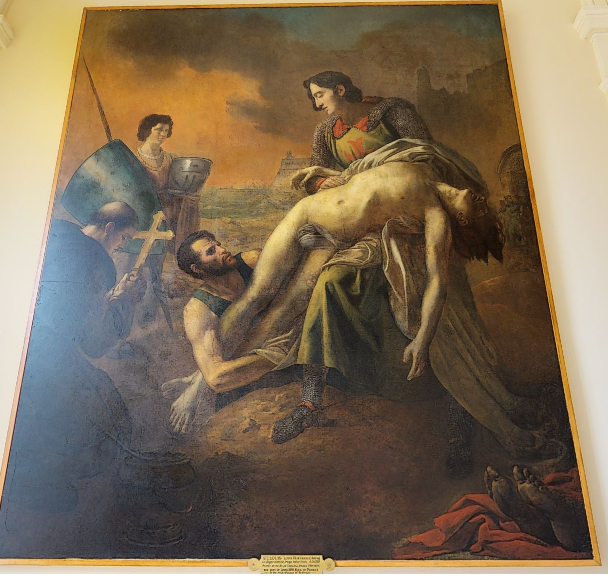
The archbishop begins his ministry in St. Louis at a time when some are calling for a statue of the Catholic saint to be removed from Forest Park in St. Louis, citing his involvement in the Crusades and alleged anti-Semitic actions.
Archbishop Rozanski said when he first visited the statue, he noticed that one of its most prominent features is that the king’s sword is pointed downward and held in a way that represents the Sign of the Cross.
“For those who oppose the statue being there, I would say that the statue exemplifies the life of King Louis, a peacemaker – one who looked out for his people and who ruled over them not with dread, but with great love,” Archbishop Rozanski said. “If we reflect on that love and reflect on the values that King Louis shows us in that world, then it would be very difficult to remove that statue.”
Archbishop Rozanski said he has admiration for an oil painting of St. Louis that hangs inside the Basilica of the National Shrine of Assumption of the Blessed Virgin Mary in Baltimore. The painting, completed by Baron Charles de Steuben, shows St. Louis IX burying his pestilence-stricken officers and men near Tunis, Africa, in 1270. It was a gift to the Archdiocese of Baltimore from King Louis XVIII and was presented by his successor, Charles X in 1827.
“It’s very touching because it shows the king at work with his people, doing the corporal works of mercy and burying the dead,” Archbishop Rozanski said.
Ties that bind
Archbishop Rozanski recalled that Bishop John H. Ricard, S.S.J., current superior general of the Baltimore-based Josephites and a former auxiliary bishop of the Archdiocese of Baltimore, told him 30 years ago that the archdiocese that was most similar to Baltimore was St. Louis.
Both are about the same size, each with a current population of more than 500,000 Catholics. They also have a diverse population that includes European ethnic communities, Spanish-speaking people and African Americans. Two of their archbishops even came from the same family.
In the 19th century, Irish-born Archbishop Francis Patrick Kenrick served as an archbishop of Baltimore and his brother, Archbishop Peter Richard Kenrick, served as archbishop of St. Louis.
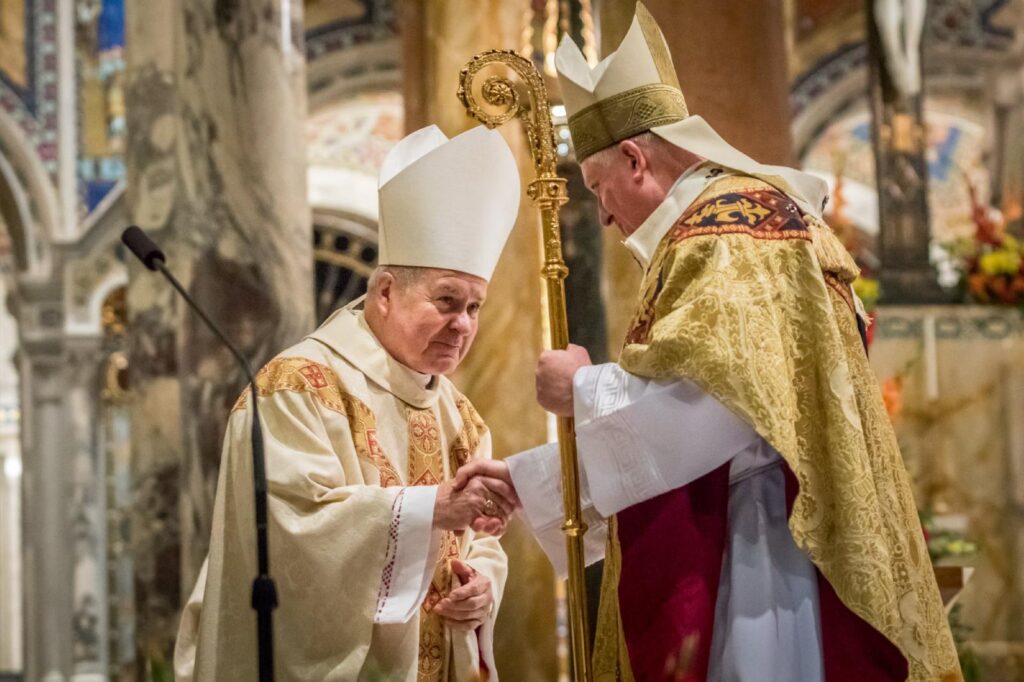
In recent decades, both communities have been roiled by racial tensions and have felt the impact of discord in the wider society.
In his installation homily, Archbishop Rozanski urged Catholics to look to the words of Jesus in the Gospel proclaimed at the archbishop’s installation: “Love one another as I have loved you.”
“In the midst of a pandemic, a societal reckoning on the life issue of race relations, an atrophied civic discourse – and yes, the often-sinful polemics we now face within our church – loving one another seems to be a tough thing to do these days,” he said. “Yet, my friends, we are called to be a people of hope.”
During his installation, Archbishop Rozanski received the pallium, a woolen cloth worn over his shoulders to symbolize his office as a metropolitan archbishop and his unity with the pope.
The liturgy also included a nod to his Polish-American heritage, with the singing of a traditional Marian hymn called “Serdeczna Matko.” While in Baltimore, Archbishop Rozanski led a spiritual pilgrimage to Poland and Eastern Europe and since 2017 he has served as the Roman Catholic co-chairman of the Polish National Catholic/Roman Catholic Dialogue. He has periodically returned to Baltimore over recent years, sometimes celebrating the traditional Thanksgiving Day polka Mass at Sacred Heart of Mary.
Support from friends
Among those attending the installation liturgy from the Archdiocese of Baltimore were several of Archbishop Rozanski’s longtime priest friends including Father James Proffitt, Monsignor Richard Hilgartner, Father William Foley, Monsignor James Barker, Father Jerry Francik and Father Jason Worley.
Father Proffitt, director of clergy personnel for the Archdiocese of Baltimore, noted that before his friend was ordained a bishop, he was a parish priest “through and through.”

“He smells like the sheep, to employ Pope Francis’ phrase,” Father Proffitt said. “The people of St. Louis can expect to see him actively engaged, not shepherding from a distance.”
Father Proffitt said Archbishop Rozanski “delivered a homerun” in his installation homily, during which the archbishop pointed to the famous St. Louis Gateway Arch as an important symbol of openness.
“We ourselves must be gateways, not gatekeepers; gateways to healing, to evangelization, to mercy, to compassion; gateways to listening with the ears of Jesus,” Archbishop Rozanski said in his homily.
Monsignor Hilgartner, pastor of St. Joseph in Cockeysville, noted that his friend confided in him after the installation that it was difficult to prepare the homily because he did not yet have any personal connections with the people of St. Louis.
“He certainly met the challenge,” said Monsignor Hilgartner, who has vacationed with Archbishop Rozanski over the years.
Dorothy Weidner, who served as Archbishop Rozanski’s secretary for 10 years when he was an auxiliary bishop of Baltimore, has known her friend since he was a seminarian. As a young priest, he was an associate pastor of her parish, St. Isaac Jogues in Carney. She said it was moving for her to watch his installation liturgy via livestream.
“He’s kind, thoughtful, caring – with a great sense of humor and deep faith,” she said. “Just having known this priest has been an honor and a blessing.”
Archbishop Rozanski said he thanks God for the “great” people he served in the Archdiocese of Baltimore. He will never forget his roots, he said.
“Wherever I am, certainly, to me, Baltimore will always be home,” he said. “And I thank God for those 30 years of ministry in the Archdiocese of Baltimore. I feel blessed for those years, but also blessed to be called to this Church of St. Louis.”
Click here to watch a livestream of the installation Mass.
Email George Matysek at gmatysek@CatholicReview.org.
Also see:
Pope names Bishop Rozanski, Baltimore native, as Archbishop of St. Louis
Bishop Rozanski’s parents nurtured his faith
Son of Mount Carmel remembered as natural leader
Special report: Deep-rooted Polish faith faces secular challenge
Copyright © 2020 Catholic Review Media
